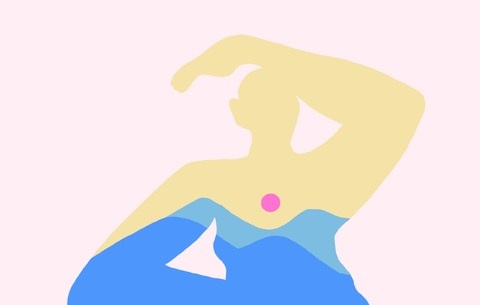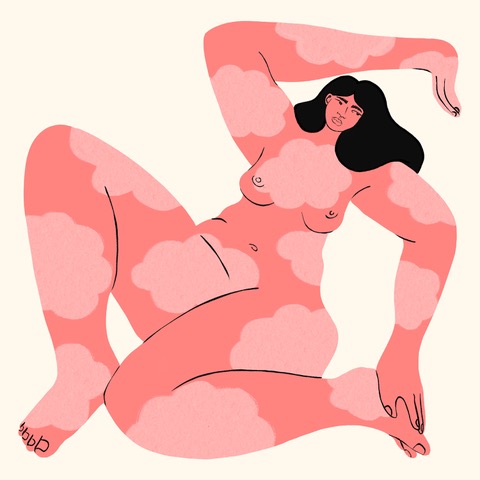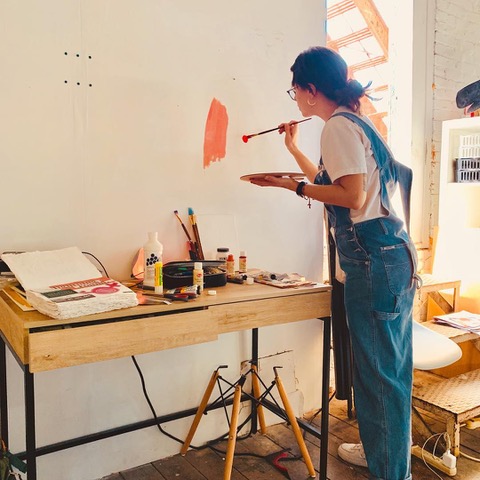For this month’s interview, we talked to Ludi Leiva, a multidisciplinary artist based in the Pacific Northwest. Ludi (short for Ludmila) mainly works as an illustrator, and her vibrant illustrations featuring intriguing human figures have appeared in Vogue, them., Twitter, and exposed in the streets of New York. In addition to being an artist, she also works as an editor and a writer, and her written work is just as impressive as her visual work. Ludi’s illustrations are also political. After she graduated from college, she was involved in activism and nonprofit work, and as a queer, Latinx artist, her illustrations aim to represent people from marginalized communities, especially women of color. Representing the marginalized is at the core of what we do here at Vagabond City, so we discussed that with Ludi, as well as what it’s like for her to be a self-taught artist, and how she manages her business.
Who are you?
Hello! My name is Ludi Leiva, and I’m a multidisciplinary artist primarily working as an illustrator. My illustration career started back in 2017 while I was still working as a journalist. I had the opportunity to do the character illustrations for a virtual reality experience that was debuting at Sundance. Around that time, I had also started picking up small illustration projects here and there, just getting my feet wet, but this was the first project that made me think “wait a minute, I can actually do this for work?”. By the end of that year, I’d bought myself an iPad Pro and finally committed to taking illustration more seriously, sharing my work on social media and putting myself out there. That’s how it all started.
How would you describe your aesthetic?
My work is constantly evolving as I experiment with different mediums and techniques. I’m self-taught so it’s been a really wonderful experience to just explore new things, like gouache and illustrating on different surfaces, since I never got to do that in art school. But generally, I’d say my aesthetic is characterized by warm colors, soft shapes, and large, sometimes exaggerated bodies and organic motifs. My practice tends to focus on the female figure and I typically draw women of color, depicting them as larger than life and expanding in space.
How did you find it? How has it evolved since you began illustrating?
My style has definitely evolved since I first got started illustrating. It’s funny, I recently recreated the first image I ever illustrated on my iPad back in 2017 and it was really incredible to see just how much my style has changed and grown. I’ve experimented with new techniques and have strengthened my ability to portray and draw certain things. But I do think there’s a connecting thread in my work. It’s something that’s fascinating and exciting for me because as an artist I’m influenced by so many things: my surroundings, my lived experiences, my mood, what’s going on around me,… So my work will never remain static in light of all of this.
What inspires you? Which artists have influenced your work the most?
I’m inspired by the human condition, by our inner worlds, by memory, metaphysics, and healing, particularly through a connection to other living things. I would say that’s a pretty consistent inspirational theme in all of my work. As far as artists, there are so many whose work I love, but I’d say a couple of artists whose work I consistently admire are Hilda Palafox, Sofia Salazar, and Cristina Banban.
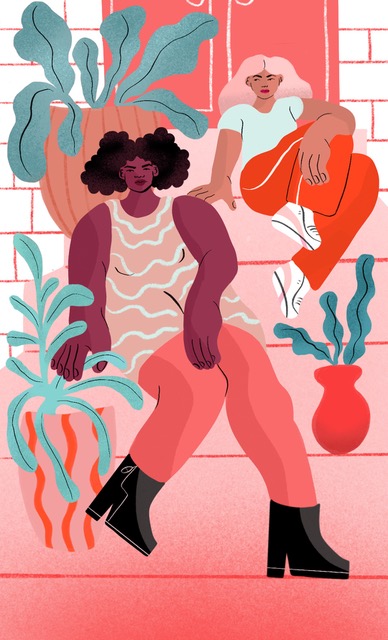
How do you work? What are the different steps in the making of an illustration?
The answer really depends. I try to sketch as much as possible just to experiment with new techniques, get shapes and figures out of my mind and onto a page somewhere for safekeeping. Sometimes I’ll work on a personal illustration for months before I finally “finish” it or share it, and even then sometimes I’ll decide it’s actually not done. In that sense, my personal illustration project is quite fluid, and can live a full life as a drawing on paper before then being transmuted into digital form, or visa versa, as a digital sketch before being painted onto a canvas. But for client-related work, I typically follow a pretty straightforward process, creating a few sketches and then finessing that into a final product through rounds of refinements. Sometimes I work with an art director, and other times they’re self-directed. It really depends on the project.
What does a workday look like for you?
2020 was a really tumultuous year, and my days were all over the place! I lost access to an art studio after I left Berlin in March, so during the rest of the year I was moving around a lot and didn’t have a set place to work, which was difficult and meant that my days were pretty unpredictable. But it was also beautiful because I found myself doing a lot of sketching and working in parks or in outdoor spaces, which was a nice change. Now, I’ve got a studio again, and I am being a lot more intentional about my practice. But my time is generally split between client work and personal work. I recently launched an online shop where I sell prints and stationery and other illustrated items, so I have been feeling a lot more inspired to create for that purpose. I feel so honoured that my work is hanging in so many people’s homes now. On any given day, I’ll start by answering emails, figuring out my to-do list, triaging things, then I will tackle the things that are pressing, whether that’s finishing up sketches or revisions for a client, or going back and forth about a contract for a new project. Some days I’ll spend more time actually illustrating, other days it’s a lot of administrative work, which is the nature of running your own business. I do have an incredible assistant, Mariah, who is a blessing and helps me a lot as well. But I try to carve out time during the week to just be and not spend all my waking hours in front of screens. I meditate every morning, and take breaks to go for a walk or do yoga. And I (almost) always take Fridays off.
Have you ever wanted to experiment with other art forms?
Definitely. I will always have a part of me that is sad that I didn’t get my Bachelor’s in Fine Arts and get to run wild exploring different mediums and practices (though I am considering an MFA, so maybe I’ll still get my chance!). But the answer is yes, and in the past couple years I started painting. I’ll never forget the first large-scale painting/mural I created in my old studio in New York. I just sketched an enormous figure on the wall and got to work. It was the most freeing feeling. Because I’ve been hopping around all over the place in the past years, it was a bit harder to maintain a painting practice because I wasn’t always able to have my painting supplies with me, but now that I’ve settled a bit more for now, I definitely plan to do more painting. I am also in discussions with clients about a couple of mural projects, so that will be really exciting. Overall, though, I really don’t want my entire practice to be digital. While I love the immediacy of digital illustration—especially for client work that has various iterations—I want to challenge myself with slower, more analog forms and continue to grow my artistry in this way.
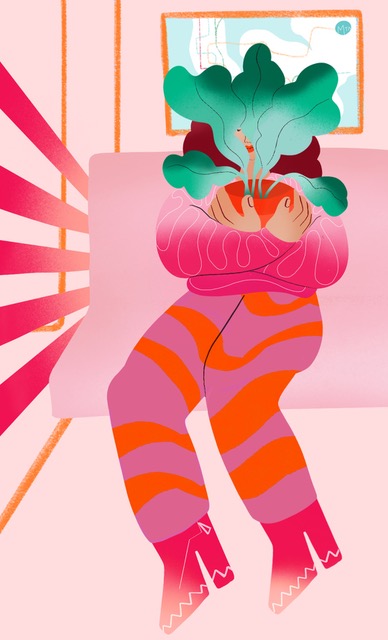
What was your favorite experience in your career?
I’ve honestly been so fortunate to have worked on so many incredible projects in the past couple of years. Sometimes I think back and I am just overwhelmed with gratitude for the opportunities I’ve had. But I’d say one of my favorite experiences was getting to create a series of illustrations for LinkNYC last March. I created a series inspired by city dwellers’ connection to plants and green spaces. Having lived in NYC for more than four years, plants were such a lifeline for me in that sprawling concrete and steel city, and I know I wasn’t alone. For two weeks, my illustrations were displayed across thousands of kiosks all around New York City and were seen by millions of people. I got such an incredible response and was able to connect with so many New Yorkers; I was really humbled that my work was shown in that way and I’ll never forget it.
You wrote on your Tumblr that your work “seeks to uplift and center marginalized narratives and individuals, particularly women of color”. How do you achieve that? How do you use art as a form of activism?
I feel called to portray women of diverse identities, shapes, and backgrounds in my work. It’s my intention to portray women and femmes in a way that celebrates us and our multiplicities. I’m queer and Latina myself, and my identities of course influence my work greatly. I will say, though, while this is a guiding intention, it’s not a box that is simply checked off—it’s a desire that continuously guides my work, but it’s not up to me to decide whether it has been achieved, if that makes sense. In terms of art as activism, it’s important to me to say something through my work, to provide commentary, to bear witness to things, to communicate a desire for a better, more equitable world. It’s not just about aesthetics.
Is there anything you’d like to achieve in your career?
One day, in a post-COVID-19 world, I’d like to have a solo show with paintings and illustrations. I’d also like to focus on doing more editorial work because it’s a great challenge in communicating and strengthening narrative. I’m also a writer, and I would love to one day work on a graphic novel or some sort of hybrid project of writing and illustration. Beyond that, I’d like to continue growing and learning on the trajectory I’m on. I try to maintain a one-day-at-a-time attitude, showing up each day and doing my best. I trust this will guide me to the places I’m meant to go.
What would you like people to feel through your work?
I suppose I’d hope they feel connected to something greater, to their own greatness. I also hope they’ll feel introspective, uplifted, or stirred in some way. The goal is to feel something—doesn’t matter what it is.
What have you been watching, reading, and listening to lately?
The last books I read were My Year of Rest and Relaxation by Ottessa Moshfegh and What My Mother and I Don’t Talk About edited by Michele Filgate. Both were very good. The most recent film I watched was Spirited Away (for the fourth time), and it’s always a favorite—I love Studio Ghibli. This week, I’ve been listening to a lot of Ahmad Jamal, Dorothy Ashby, and also just generally a lot of piano and instrumentals.
What is next for you?
I already have a few projects lined up that I’m excited to be working on this year. I am interested in doing more projects in collaboration with other artists, studios, and small brands. I’m working on more and more physical objects and wearables, and it feels really cool to think of people wearing or using things with my art on them. I have some projects planned with DULA, an art collective I’m part of. And I’m focusing on diving into more design theory and getting out my paints as much as I can. But, more generally, I’m kind of going where the wind blows me. If 2020 taught me anything, it’s not to hold so tightly to expectations, to relinquish a bit of control and just show up in every moment and do my best—to walk towards things and people that bring me joy and challenge me, and put one foot in front of the other, trusting I’ll be carried down the right paths.

Ludi Leiva is a Guatemalan-Slovak multidisciplinary artist primarily working as an illustrator. She uses visual art to explore narratives related to the human condition, particularly women’s inner worlds. Her preferred mediums and aesthetic styles are ever-evolving, but central to her practice are exaggerated and organic shapes and vibrant colors, with the female body as a central figure. Some of her recent clients include The Smithsonian, Samsung, The Guardian, and Condé Nast.
You can see more of Ludi’s work on her website and her Instagram, and follow her on Twitter.
